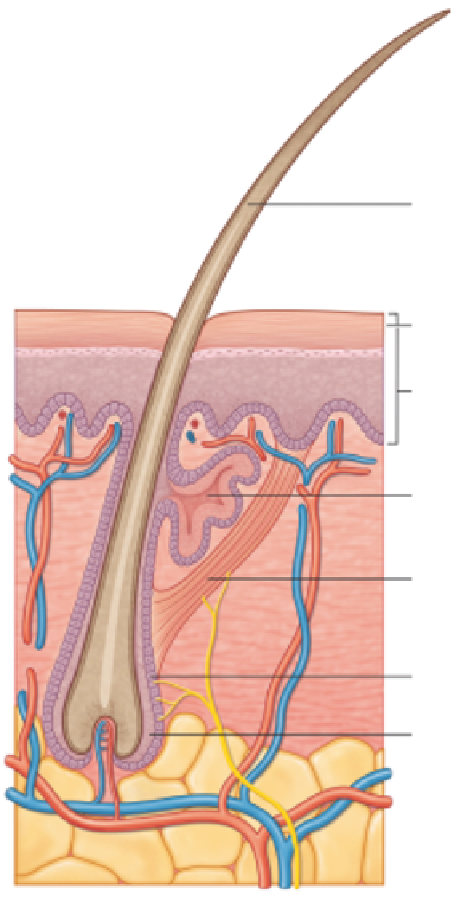Biomedical Engineering Reference
In-Depth Information
key factors in optimizing treatment
The ability to selectively target hair follicles with lasers and light
sources has revolutionized the ability to eliminate unwanted
hair temporarily and permanently in many individuals. As laser
technology advances, the ability to treat individuals of all skin
types and all hair colors broadens. Proper patient selection, pre-
operative preparation, informed consent, understanding of the
principles of laser safety, and laser and light source selection are
key to the success of laser treatment. An understanding of hair
anatomy, growth, and physiology, together with a thorough
understanding of laser-tissue interaction, in particular within
the context of choosing optimal laser parameters for effective
LHR, should be acquired before using lasers for hair removal.
Hair shaft
Stratum
corneum
Patient Selection
Despite the seemingly cosmetic nature of LHR, a complete med-
ical history, physical examination and informed consent, includ-
ing setting realistic patient expectations and potential risks,
should be preformed prior to any laser treatment (Table 5.2).
Any patient with evidence for endocrine or menstrual dysfunc-
tion should be appropriately worked up. Similarly, patients with
an explosive onset of hypertrichosis should be evaluated for
paraneoplastic etiologies. Treatment of a pregnant woman
for nonurgent conditions is discouraged, although there is no
evidence suggesting a potential risk to pregnant women under-
going LHR. The past medical history should be reviewed to
identify patients with photosensitive conditions, such as the
autoimmune connective tissue disorders, or disorders prone to
the Koebner phenomenon. A history of recurrent cutaneous
infections at or in the vicinity of treatment area might warrant
the use of prophylactic medications. Any past history of keloid
or hypertrophic scar formation should be elicited as well. Previ-
ous methods for hair removal, including any past laser treat-
ments, should be reviewed. Any methods of epilation, such as
waxing or tweezing, that entirely remove the target chromo-
phore, render LHR less effective for at least 2 weeks. Although
there is little evidence for the time frame a patient must wait
after complete epilation of the hair shaft and laser treatment, we
recommend a minimum of 6 weeks. Shaving and depilatory
creams can be used up to the day of laser treatment as they do
not remove the entire hair shaft.
A thorough medication history should be obtained. Any
history of gold intake is a contraindication for laser therapy.
The use of any photosensitizing medications or over-the-
counter supplements should also delay treatment until these
medications can be safely discontinued. There is controversy
as to whether patients on isotretinoin should be treated with
laser, although conventionally most practitioners recommend
a 6-month to 1-year washout period prior to ablative resurfac-
ing laser treatment (17-19). Whether this recommendation is
appropriate for other laser procedures is speculative at best.
Topical retinoids used in the treatment area should be discon-
tinued 1-2 days prior to treatment.
The physical examination should evaluate the patient's
Fitzpatrick skin phototype. This will help determine which
lasers and light sources are safe to use for that patient
(Table 5.1), because epidermal melanin in darkly pigmented
patients can compete with the melanin within hair follicles as
Epidermis
Sebaceous
gland
Arrector pili
muscle
Bulge region
Papilla/matrix
Figure 5.1
Hair follicle anatomy.
Source
: From Ref. 66.
However, to achieve permanent hair removal the biological
“target” is likely the follicular stem cells located in the bulge
region and/or dermal papilla. Based on the slight spatial separa-
tion of the chromophore and desired target, an extended theory
of selective photothermolysis was proposed, which requires dif-
fusion of heat from the chromophore to the desired target for
destruction (15). This requires a laser pulse duration that is lon-
ger in duration than if the actual chromophore and desired tar-
get were identical. Temporary LHR can result when the follicular
stem cells are not completely destroyed, primarily through
induction of a catagen-like state in pigmented hair follicles.
Temporary LHR is much easier to achieve than permanent
removal, using lower fl uences. Long-term hair removal depends
on hair color, skin color, and tolerated fl uence. Roughly 15-30%
long-term hair loss may be observed with each treatment when
optimal treatment parameters are used (16). The remaining
hairs are also thinner and lighter in color (Fig. 5.2). A list of laser
and light devices that are commercially available at the time of
this publication for hair removal are summarized in Table 5.1.
















